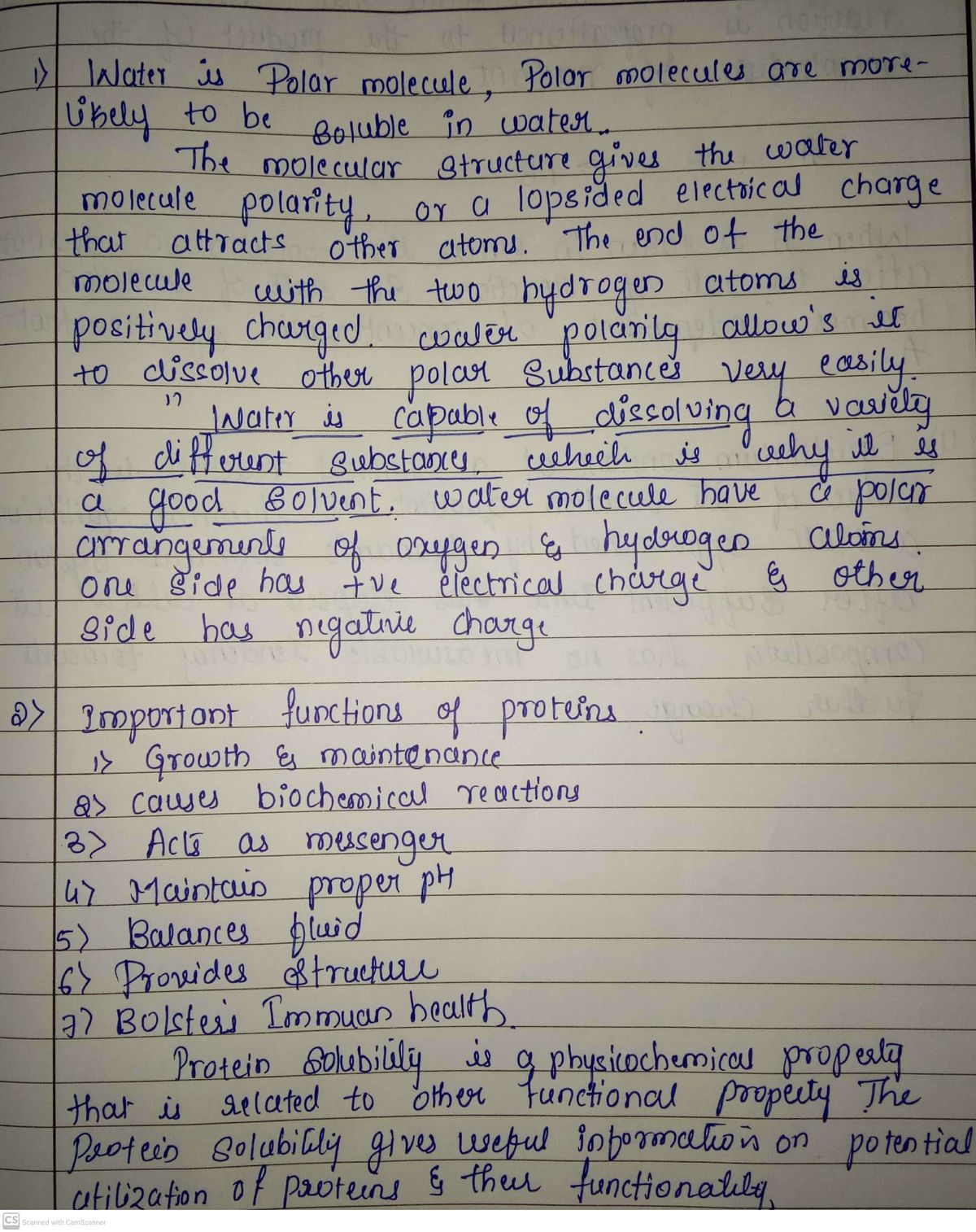IS water a polar or non-polar molecule? Are polar or non-polar molecules more likely to be soluble in water? How does the structure of a water molecule contribute to the properties of water as a solvent (e.g. it is polar, it takes a lot of heat change the temperature, etc.)? Compare and contrast the composition, structure, and functions of the four major groups of biomolecules. Which monomers are used to make polymers in each group (except lipids)? Be able to identify molecules from each group base on chemical structure (e.g.carbohydrate, nucleotide, phospholipid, amino acid, etc.) List the important functions of soluble proteins in the body. What is the law of mass action? Consider the chemical reaction A+ B → AB. If we add more of substance A, what will happen to the amount of substance B and AB? What is an equilibrium constant (Keg)? Describe how the binding of a ligand to a protein is regulated (e.g. different isoforms, activation, modulation). Describe modulotion lo g comnetitive allosteric etc )
IS water a polar or non-polar molecule? Are polar or non-polar molecules more likely to be soluble in water? How does the structure of a water molecule contribute to the properties of water as a solvent (e.g. it is polar, it takes a lot of heat change the temperature, etc.)? Compare and contrast the composition, structure, and functions of the four major groups of biomolecules. Which monomers are used to make polymers in each group (except lipids)? Be able to identify molecules from each group base on chemical structure (e.g.carbohydrate, nucleotide, phospholipid, amino acid, etc.) List the important functions of soluble proteins in the body. What is the law of mass action? Consider the chemical reaction A+ B → AB. If we add more of substance A, what will happen to the amount of substance B and AB? What is an equilibrium constant (Keg)? Describe how the binding of a ligand to a protein is regulated (e.g. different isoforms, activation, modulation). Describe modulotion lo g comnetitive allosteric etc )
Chemistry
10th Edition
ISBN:9781305957404
Author:Steven S. Zumdahl, Susan A. Zumdahl, Donald J. DeCoste
Publisher:Steven S. Zumdahl, Susan A. Zumdahl, Donald J. DeCoste
Chapter1: Chemical Foundations
Section: Chapter Questions
Problem 1RQ: Define and explain the differences between the following terms. a. law and theory b. theory and...
Related questions
Question

Transcribed Image Text:Chapter 2:
ange over time? If setpoints can change over time, what is this called?
IS water a polar or non-polar molecule? Are polar or non-polar molecules more likely to be soluble in water? How does
the structure of a water molecule contribute to the properties of water as a solvent (e.g. it is polar, it takes a lot of heat to
change the temperature, etc.)?
Compare and contrast the composition, structure, and functions of the four major groups of biomolecules. Which
monomers are used to make polymers in each group (except lipids)? Be able to identify molecules from each group based
on chemical structure (e.g.carbohydrate, nucleotide, phospholipid, amino acid, etc.)
List the important functions of soluble proteins in the body.
What is the law of mass action? Consider the chemical reaction A + B → AB. If we add more of substance A, what will
happen to the amount of substance B and AB?
What is an equilibrium constant (Keg)?
Describe how the binding of a ligand to a protein is regulated (e.g. different isoforms, activation, modulation). Describe
the different types of modulation (e.g. competitive, allosteric, etc.)
sui
Expert Solution
Step 1

Trending now
This is a popular solution!
Step by step
Solved in 2 steps with 2 images

Knowledge Booster
Learn more about
Need a deep-dive on the concept behind this application? Look no further. Learn more about this topic, chemistry and related others by exploring similar questions and additional content below.Recommended textbooks for you

Chemistry
Chemistry
ISBN:
9781305957404
Author:
Steven S. Zumdahl, Susan A. Zumdahl, Donald J. DeCoste
Publisher:
Cengage Learning

Chemistry
Chemistry
ISBN:
9781259911156
Author:
Raymond Chang Dr., Jason Overby Professor
Publisher:
McGraw-Hill Education

Principles of Instrumental Analysis
Chemistry
ISBN:
9781305577213
Author:
Douglas A. Skoog, F. James Holler, Stanley R. Crouch
Publisher:
Cengage Learning

Chemistry
Chemistry
ISBN:
9781305957404
Author:
Steven S. Zumdahl, Susan A. Zumdahl, Donald J. DeCoste
Publisher:
Cengage Learning

Chemistry
Chemistry
ISBN:
9781259911156
Author:
Raymond Chang Dr., Jason Overby Professor
Publisher:
McGraw-Hill Education

Principles of Instrumental Analysis
Chemistry
ISBN:
9781305577213
Author:
Douglas A. Skoog, F. James Holler, Stanley R. Crouch
Publisher:
Cengage Learning

Organic Chemistry
Chemistry
ISBN:
9780078021558
Author:
Janice Gorzynski Smith Dr.
Publisher:
McGraw-Hill Education

Chemistry: Principles and Reactions
Chemistry
ISBN:
9781305079373
Author:
William L. Masterton, Cecile N. Hurley
Publisher:
Cengage Learning

Elementary Principles of Chemical Processes, Bind…
Chemistry
ISBN:
9781118431221
Author:
Richard M. Felder, Ronald W. Rousseau, Lisa G. Bullard
Publisher:
WILEY